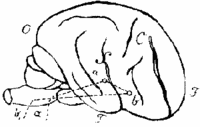Wernicke had a male patient who had suffered a stroke, despite still being able to speak and hear, the man could barely understand what was said to him nor could he understand written words. Following the death of the patient, Wernicke conducted an autopsy and found a lesion in the rear parietal/temporal region of the patient's left brain hemisphere. Wernicke concluded that this region was involved in speech comprehension as it was close to the auditory region of the brain. Wernicke named the syndrome sensory aphasia[2] but it is now usually known as Wernicke's aphasia[3] and the affected region of the brain is known as Wernicke's area. Scientists now believe that Wernicke's area may be involved in semantic processing, and it is sometimes called the receptive language area.
